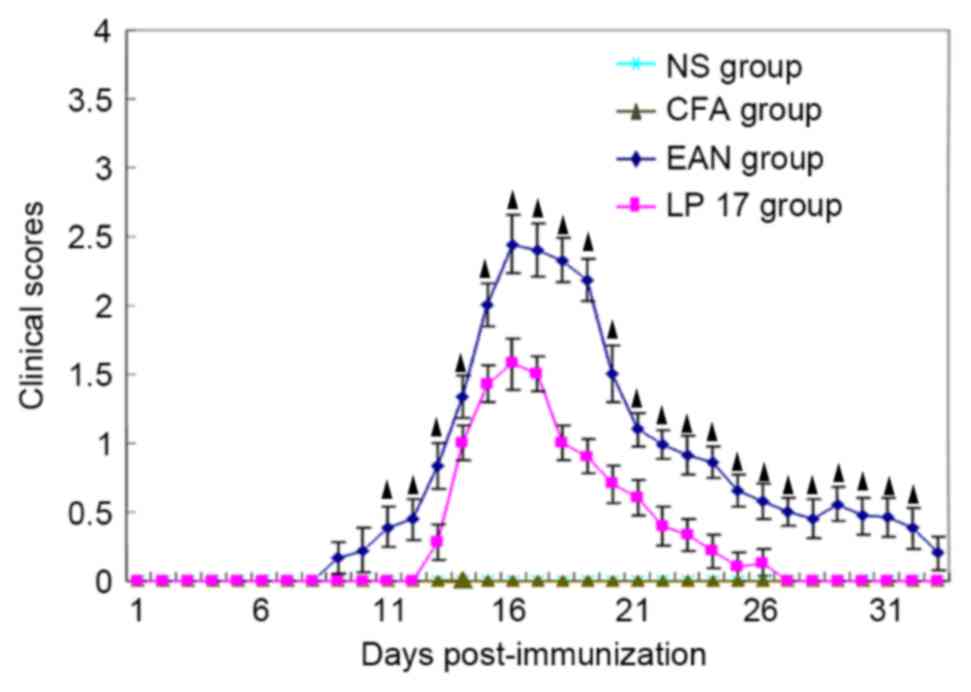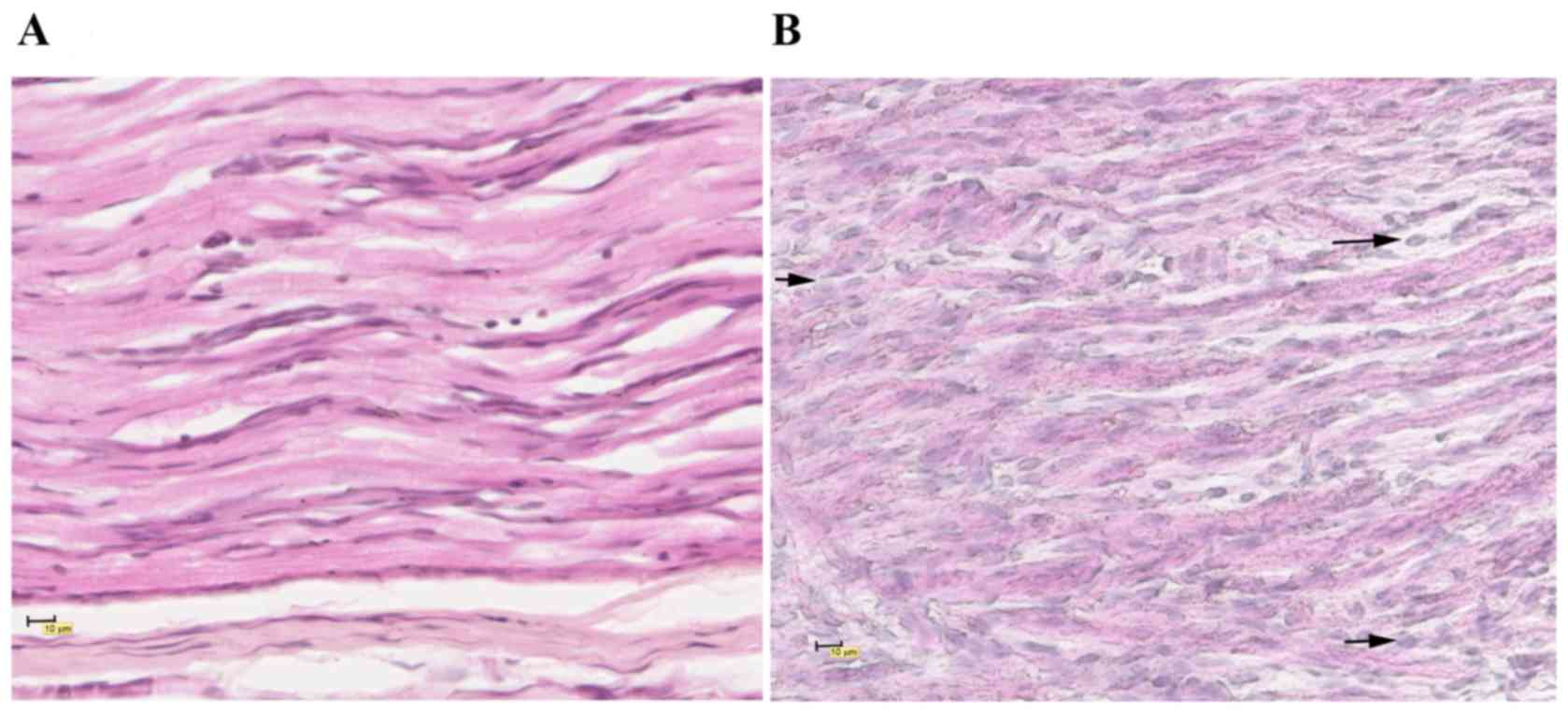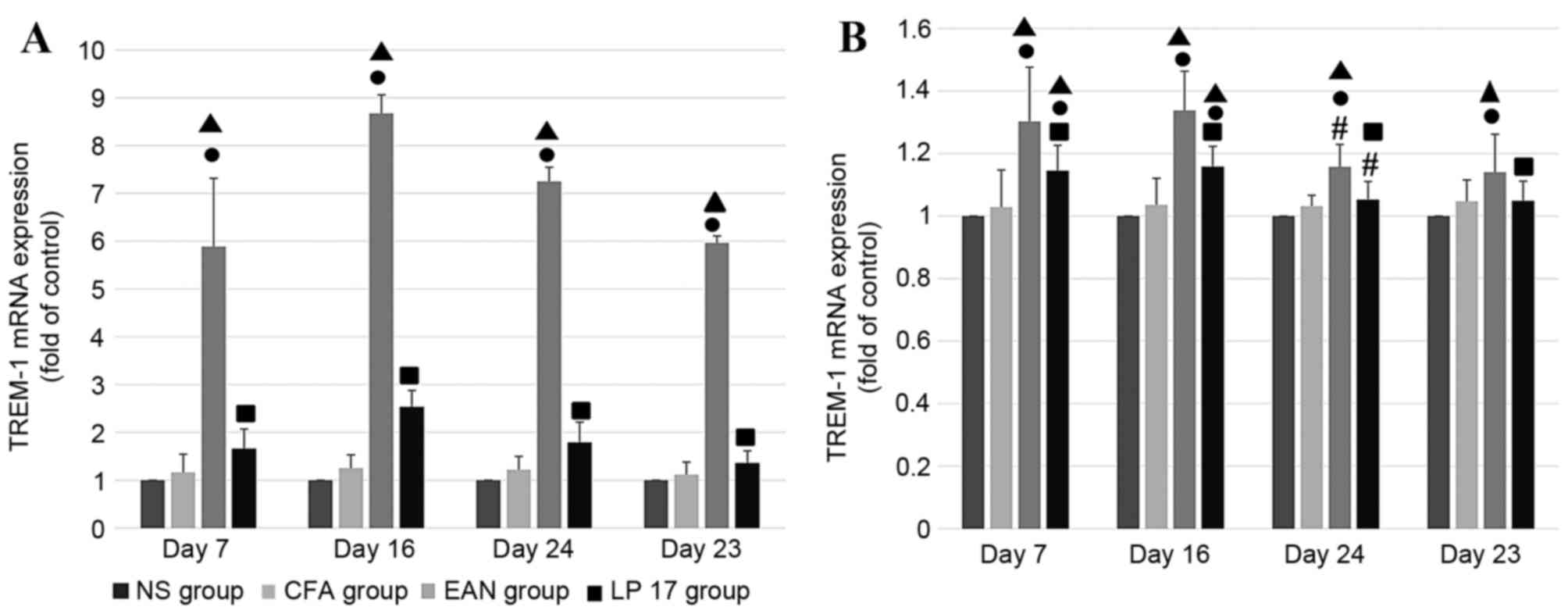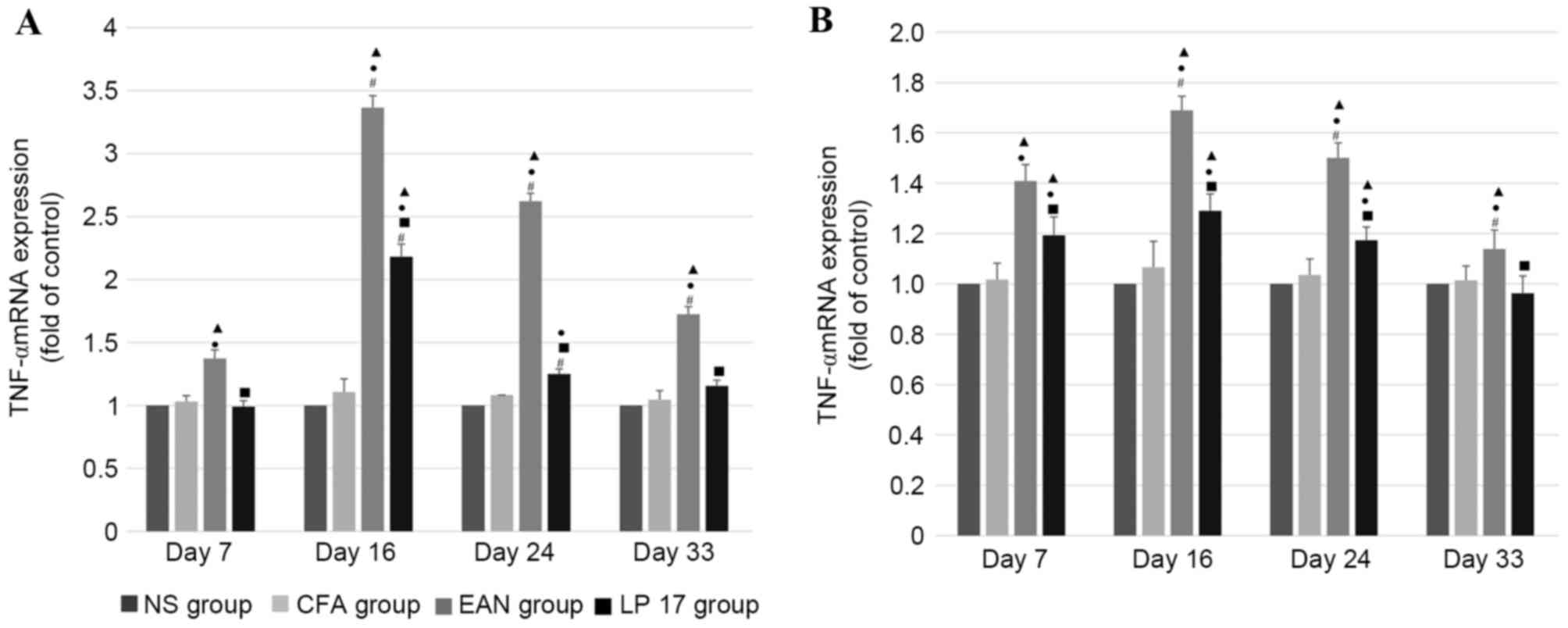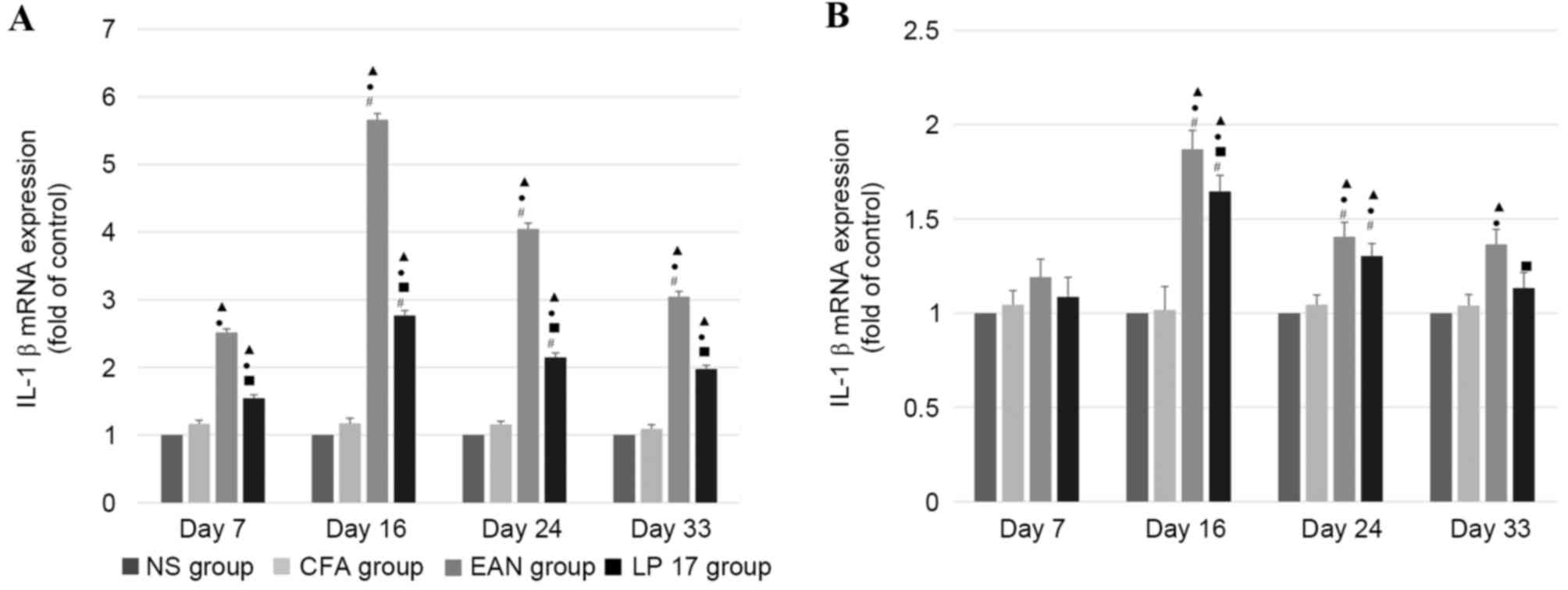Inhibition of triggering receptor expressed on myeloid cells-1 ameliorates experimental autoimmune neuritis
- Authors:
- Published online on: February 6, 2017 https://doi.org/10.3892/mmr.2017.6167
- Pages: 1565-1570
-
Copyright: © Zhou et al. This is an open access article distributed under the terms of Creative Commons Attribution License.
Abstract
Introduction
Experimental autoimmune neuritis (EAN) is a cluster of differentiation (CD) 4+ T cell-mediated inflammatory demyelinating disease of the peripheral nervous system (PNS) (1). EAN serves as a useful animal model for Guillain-Barré syndrome (GBS), which is a CD4+ T cell-mediated disease of the PNS in humans (2).
Triggering receptor expressed on myeloid cells-1 (TREM-1) is a 30-kDa glycoprotein associated with DNAX-activation protein of 12 kDa (DAP12), which is an immunoreceptor tyrosine-based activation motif-containing adaptor protein (3). TREM-1 is selectively expressed on blood neutrophils and on a subset of monocytes (4,5) and may amplify the inflammatory response (5–7). TREM-1 induces the production of chemokines and cytokines via DAP12 (3). TREM-1 additionally regulates signaling pathways induced by known classes of pattern-recognition receptors, including Toll-like receptors and neuronal apoptosis inhibitory proteins (4). Previous studies have demonstrated that TREM-1 is associated with numerous types of autoimmune diseases, including inflammatory bowel diseases (8), acute pancreatitis (9), neoplastic pleural effusions (10) and rheumatoid arthritis (11). TREM-1 influences chronic heart rejection by regulating the infiltration and differentiation of CD4+ lymphocytes (12). In addition, TREM-1 has a tumor promoting effect (13).
Although TREM-1 has been widely studied, its role in EAN/GBS remains to be investigated. To determine whether TREM-1 is involved in the pathogenesis of EAN, the present study treated the animal model of EAN with linear plasmid 17 (LP 17), an analogue synthetic peptide derived from the extracellular moiety of TREM-1 (14). The symptoms of rats and the mRNA expression levels of tumor necrosis factor (TNF)-α, interleukin (IL)-1β and TREM-1 in sciatic nerves and peripheral blood mononuclear cells (PBMCs) were subsequently assessed. The results of the present study suggested that TREM-1 may serve a role in the pathogenesis of EAN.
Materials and methods
Animal models
Animal procedures were approved by Xiangya Hospital Ethics Committee, Xiangya Hospital (Changsha, China). The Guidelines for Ethical Conduct in the Care and Use of Vertebrate Animals in Research and Training by the American Physiological Society Council were followed (15).
Specific pathogen free male Lewis rats (age, 6–8 weeks; weight, 160–180 g; n=64) were purchased from Vital River Laboratories Co., Ltd. (Beijing, China) and were housed in groups of two or three per cage under controlled conditions: Light-dark cycle, 12-h; background noise, 40±10 dB; relative humidity, 50–60%; temperature, 20±3°C; and food and water ad libitum. Rats were acclimatized for one week, following which they were randomly assigned to four groups: Normal saline (NS), complete Freund's adjuvant (CFA), EAN and LP 17.
Myelin P2 peptides 53–78 (THR-GLU-SER-PRO-PHE-LYS-ASN-THR-GLU-ILE-SER-PHE-LYS-LEU-GLY-GLN-GLU-PHE-GLU-GLU-THR-THR-ALA-ASP-ASN-ARG) were synthesized by solid-phase stepwise elongation using a Tecan peptide synthesizer (GL Biochem Ltd., Shanghai, China).
The EAN animal model was created by injecting the two hind-foot pads with 200 µl antigen emulsion containing 100 µg P2 53–78 emulsified in 100 µl saline and 100 µl Freund's incomplete adjuvant (FIA; Sigma-Aldrich; Merck Millipore, Darmstadt, Germany) containing 5 mg/ml heat-inactivated Mycobacterium tuberculosis H37RA (Beijing Institute of Biological Products, Co., Ltd., Beijing, China) (16). The FIA + Mycobacterium tuberculosis H37RA mixture was referred to as CFA.
Rats in the NS group were injected with 200 µl sterile saline, and rats in the CFA group with 200 µl CFA. The NS and CFA groups served as controls. Rats in the LP 17 group were injected with 200 µl antigen emulsion and a single dose (4 mg/kg, dissolved in 500 µl NS and injected intraperitoneally) of LP 17 (GL Biochem Ltd., Shanghai, China) administered immediately following the footpad injection.
Body weight and clinical scores were assessed immediately prior to immunization and every day following immunization until 33 days post-immunization (PI). The timeline of the experiment was numbered as days PI. Severity of paresis was graded as follows: 0=normal; 1=flaccid tail; 2=moderate paraparesis; 3=severe paraparesis; 4=tetraparesis (16).
Sample collection
Each group contained four subgroups (n=4/subgroup) that were sacrificed at different days PI: 7 (phase 1: Onset of disease), 16 (phase 2: Disease peak), 24 (phase 3: Early recovery phase) and 33 (phase 4: Late recovery phase). Prior to sacrifice, rats anesthetized with an intraperitoneal injection of 36 mg/kg 3% chloral hydrate (Xiangya Hospital, Changsha, China) to draw blood and to carefully separate the bilateral sciatic nerves (stored at −80°C for mRNA analysis and collected for histopathological assessment, respectively), and then the anesthetized rats were sacrificed in a 0.015 l CO2 gas chamber, where the rats received a 100% CO2 air flow for 10 min. Mortality was confirmed with no heartbeat/breath by at least two technicians (Xiangya Hospital, Changsha, China).
Blood samples (~5 ml) were obtained from the jugular vein and collected in EDTA-coated tubes. PBMCs were isolated by gradient centrifugation using LymphoPrep™ solution (Beijing Dingguo Changsheng Biotechnology Co., Ltd., Beijing, China), and the whole blood was centrifuged at 1,200 × g for 15 min at 4°C. The buffy coat was mixed with RPMI-1640 (Sigma-Aldrich; Merck Millipore). The buffy coat/RPMI mix was layered on top of endotoxin-free LymphoPrep and centrifuged at 1,200 × g for 25 min at 4°C. PBMCs separated out into a distinct layer that was removed, washed twice with RPMI-1640 and centrifuged at 600 × g for 10 min at 4°C, then 400 × g for 10 min at 4°C. Following three washes with PBS, PBMCs were collected for RNA extraction.
Histopathological assessment of EAN
Sciatic nerves were isolated and fixed overnight in 4% paraformaldehyde at 4°C. Each sciatic nerve was cut into segments ~5-mm long, which were embedded in paraffin blocks, sectioned serially (4 µm), and mounted on polylysine-treated slides (Beijing Dingguo Changsheng Biotechnology Co., Ltd.). Hematoxylin and eosin (H&E) staining was performed to observe inflammatory cell infiltration in the nerves (17,18). This served to validate the EAN animal model.
Reverse transcription-quantitative polymerase chain reaction (RT-qPCR)
Total RNA was isolated from PBMCs and sciatic nerves using TRIzol® reagent (Invitrogen; Thermo Fisher Scientific, Inc., Waltham, MA, USA). RNA purity and concentration were confirmed by spectrophotometry with a wavelength of 450 nm using the NanoDrop ND-1000 Spectrophotometer (NanoDrop Technologies; Thermo Fisher Scientific, Inc.) cDNA was synthesized using a Reverse-Transcription kit (Toyobo Co., Ltd., Osaka, Japan) and an ABI StepOnePlus™ PCR system (Applied Biosystems; Thermo Fisher Scientific, Inc.).
Primer sequences were as follows: Forward, 5′-TTCAACGGCACAGTCAAG-3′ and reverse, 5′-CCAGCATCACCCCATTT-3′ for TREM-1; forward, 5′-CCTGGTCACCAAATCAGCATTA-3′ and reverse, 5′-GAAGCTGTCTTCAGGCCAACAT-3′ for TNF-α; forward, 5′-ATGAGAGCATCCAGCTTCAAATC-3′ and reverse, 5′-CACACTAGCAGGTCGTCATCATC-3′ for IL-1β; and forward, 5′-TTCAACGGCACAGTCAAG-3′ and reverse, 5′-CCAGCATCACCCCATTT-3′ for GAPDH. The primers were synthesized by Sangon Biotech Co., Ltd. (Shanghai, China). cDNAs were amplified with SYBR Green using the Platinum SYBR-Green qPCR SuperMix UDG (Invitrogen; Thermo Fisher Scientific, Inc.). A RevertAid First Strand cDNA synthesis kit (Thermo Fisher Scientific, Inc.) and nuclease-free water (Thermo Fisher Scientific, Inc.) were also used during the process of qPCR.
Cycling conditions were identical for all primer pairs: An initial denaturation step at 95°C for 1 min, followed by 40 cycles at 95°C for 15 sec and 65°C for 1 min. The results were automatically analyzed using the ABI StepOnePlus PCR system and the 2−ΔΔCq method was used to analyze mRNA expression (ΔCq represents the difference in quantification cycle value between the target gene and the internal control; ΔΔCq represents the difference in ΔCq between groups) (19). Three independent RT-qPCR reactions were performed.
Statistical analysis
Data are presented as the mean ± standard deviation. Analyses were performed using SPSS software version 18.0 (SPSS, Inc., Chicago, IL, USA). Differences between groups were evaluated by one-way analysis of variance with Bonferroni post-test analyses. P<0.05 was considered to indicate a statistically significant difference.
Results
Clinical and histopathological alterations
Rats in the EAN group (n=16) appeared healthy prior to immunization and began to exhibit fatigue and tail weakness 9 to 11 days PI. They had the greatest clinical score (2.44±0.21; n=12) on day 16 and then gradually recovered, with complete recovery by day 33 (n=4). Severity of disease in the LP 17 group was reduced compared with the EAN group (P<0.05; Fig. 1); however, the clinical score of the LP 17 group also peaked on day 16 (1.57±0.19; n=12; Fig. 1).
The infiltration of inflammatory cells in the LP 17 group (Fig. 2A) was markedly reduced compared with the EAN group (Fig. 2B), and fewer histopathological alterations were observed.
TREM-1 mRNA expression levels
In sciatic nerves (Fig. 3A) and PBMCs (Fig. 3B), mRNA expression levels of TREM-1 were increased across all phases in the EAN group compared with the CFA and NS groups (P<0.05). The expression levels of TREM-1 mRNA were markedly increased in sciatic nerves compared with PBMCs. In the PBMCs, mRNA expression levels of TREM-1 in the EAN and LP 17 groups differed significantly between the disease peak phase and early recovery phase (P<0.05). Compared with the control groups, mRNA expression levels of TREM-1 in PBMCs were increased in the LP 17 group at the onset of disease (day 7) and disease peak (day 16) phases (P<0.05).
TNF-α mRNA expression levels
In sciatic nerves (Fig. 4A) and PBMCs (Fig. 4B), mRNA expression levels of TNF-α were increased in the EAN group compared with the control and LP 17 groups across all phases (P<0.05), and there was a significant difference between each phase within the EAN group (P<0.05).
In sciatic nerves, the mRNA expression levels of TNF-α were significantly different across the first three phases within the LP 17 group (P<0.01). mRNA expression levels of TNF-α in the sciatic nerves of the LP 17 group were increased compared with the NS and CFA groups at disease peak (P<0.05) and were increased compared with the NS group in the early recovery phase (P<0.05). TNF-α mRNA levels were markedly increased in the EAN group compared with the LP 17 group (P<0.01).
In PBMCs, TNF-α mRNA expression levels were increased in the LP 17 group compared with the control groups in the first three phases (P<0.05), and there were significant differences between the EAN and LP 17 groups across all phases (P<0.05).
IL-1β mRNA expression levels
In sciatic nerves (Fig. 5A), mRNA expression levels of IL-1β were increased in the EAN group compared with the control and LP 17 groups across all phases (P<0.05), and were significantly different between each phase within the EAN group (P<0.05). IL-1β mRNA expression levels in the LP 17 group were increased compared with the control groups; however, were reduced compared with the EAN group across all phases (P<0.05).
IL-1β mRNA expression levels in PBMCs (Fig. 5B) were increased in the EAN group compared with the LP 17 group at the disease peak and late recovery phases (P<0.05). Compared with the control groups, mRNA expression levels of IL-1β were increased in the EAN and LP 17 groups in the disease peak and early recovery phases (P<0.05).
In sciatic nerves and PBMCs, IL-1β mRNA expression levels were significantly different between the first three phases within the EAN and LP 17 groups (P<0.05).
Discussion
TREM-1 potently amplifies inflammatory responses by enhancing degranulation and secretion of proinflammatory mediators (8). Simultaneously, the activation of TREM-1 increases the expression levels of costimulatory molecules on the surface of mononuclear leucocytes (20).
Elevated TREM-1 expression levels may serve as an early indicator of poor prognosis. Previous studies have suggested that TREM-1 may represent a valuable marker for inflammatory severity and be a potential therapeutic target for the treatment of sepsis (21,22).
In the present study, the mRNA expression levels of TREM-1 closely paralleled the clinical characteristics of the disease, and mRNA expression levels of TNF-α, IL-1β and TREM-1 were greatest in the EAN group. Compared with the EAN group, mRNA expression levels of TREM-1 were markedly decreased in the LP 17 group, suggesting that LP 17 significantly inhibited the activation of the TREM-1 signaling pathway. Compared with PBMCs, TREM-1 mRNA expression levels were increased markedly in the sciatic nerve. These levels were elevated on day 7 in sciatic nerves and PBMCs, and peaked on day 16. This indicated that TREM-1 is involved in the early immune activation process of EAN.
As expected, rats in the LP 17 group experienced less weight loss and had reduced clinical scores compared with the EAN group. LP 17 did not completely inhibit EAN; however, the results of the present study demonstrated that LP 17 attenuates the symptoms of EAN in rats, indicating that TREM-1 is a potential target for the treatment of EAN.
Similarly, H&E staining revealed that infiltration of inflammatory cells in sciatic nerves was less marked in the LP 17 group on day 16 compared with the EAN group. Therefore, TREM-1 may serve a role in a series of proinflammatory processes underlying EAN.
TNF-α may increase the permeability of the blood nerve barrier (20) and is involved in the pathogenesis of EAN in rats (21). Expression levels of TNF-α were greatest in the EAN group on day 7 (onset of disease); this is consistent with its role in the early pathological phase of EAN (22). In GBS, TNF-α produced by infiltrating T cells has a direct myelinotoxic effect (23), which may contribute to the increased expression levels of TNF-α in the sciatic nerves.
A previous study demonstrated that IL-1β mRNA is expressed in the lymph nodes and sciatic nerves of rats during the early onset phase of EAN, which may be associated with the infiltration of mononuclear macrophages (24). Similarly, the results of the present study revealed that the mRNA expression levels of IL-1β were increased in the sciatic nerves of the EAN group across all phases, and in the LP 17 group were greatest at day 16. A possible explanation is that IL-1β, mediated by calpain, which is activated by calcium influx following nerve injury (25), was immediately and continuously released at the site of injury following injection of the antigen emulsion. In addition, peripheral inflammation may influence neurotransmitter metabolism, neuroendocrine function, as well as growth factor production, which modifies neural circuitry and may additionally account for the increased expression levels of IL-1β (25,26).
Although there are therapeutic benefits to the selective inhibition of TREM-1, a previous study has suggested that TREM-1 signaling is necessary for successful antimicrobial responses (24) and that inappropriate modulation of the TREM-1 signaling pathway may have profound and potentially detrimental effects on septic patients.
The present study demonstrates that TREM-1 is a potential therapeutic target for the treatment of GBS. Further studies involving expression and silencing of the TREM-1 gene are required to determine whether the protein itself is expressed, and which cells produce it.
Glossary
Abbreviations
Abbreviations:
|
EAN |
experimental autoimmune neuritis |
|
TREM-1 |
triggering receptor expressed on myeloid cells-1 |
|
PNS |
peripheral nervous system |
|
GBS |
Guillain-Barré syndrome |
|
DAP12 |
DNAX-activation protein of 12 kDa |
|
PBMCs |
peripheral blood mononuclear cells |
|
NS |
normal saline |
|
CFA |
complete Freund's adjuvant |
|
FIA |
Freund's incomplete adjuvant |
|
PI |
post-immunization |
|
H&E |
hematoxylin and eosin |
|
RT-qPCR |
reverse transcription-quantitative polymerase chain reaction |
References
|
Katzav A, Bina H, Aronovich R and Chapman J: Treatment for experimental autoimmune neuritis with clodronate (Bonefos). Immunol Res. 56:334–340. 2013. View Article : Google Scholar : PubMed/NCBI | |
|
Xu H, Li XL, Yue LT, Li H, Zhang M, Wang S, Wang CC and Duan RS: Therapeutic potential of atorvastatin-modified dendritic cells in experimental autoimmune neuritis by decreased Th1/Th17 cytokines and up-regulated T regulatory cells and NKR-P1(+) cells. J Neuroimmunol. 269:28–37. 2014. View Article : Google Scholar : PubMed/NCBI | |
|
Montalvo V, Quigley L, Vistica BP, Boelte KC, Nugent LF, Takai T, McVicar DW and Gery I: Environmental factors determine DAP12 deficiency to either enhance or suppress immunopathogenic processes. Immunology. 140:475–482. 2013. View Article : Google Scholar : PubMed/NCBI | |
|
Arts RJ, Joosten LA, van der Meer JW and Netea MG: TREM-1: Intracellular signaling pathways and interaction with pattern recognition receptors. J Leukoc Biol. 93:209–215. 2013. View Article : Google Scholar : PubMed/NCBI | |
|
Palazzo SJ, Simpson T and Schnapp LM: Triggering receptor expressed on myeloid cells type 1 as a potential therapeutic target in sepsis. Dimens Crit Care Nurs. 31:1–6. 2012. View Article : Google Scholar : PubMed/NCBI | |
|
Bouchon A, Facchetti F, Weigand MA and Colonna M: TREM-1 amplifies inflammation and is a crucial mediator of septic shock. Nature. 410:1103–1107. 2001. View Article : Google Scholar : PubMed/NCBI | |
|
Zangi L, Klionsky YZ, Yarimi L, Bachar-Lustig E, Eidelstein Y, Shezen E, Hagin D, Ito Y, Takai T, Reich-Zeliger S, et al: Deletion of cognate CD8 T cells by immature dendritic cells: A novel role for perforin, granzyme A, TREM-1, and TLR7. Blood. 120:1647–1657. 2012. View Article : Google Scholar : PubMed/NCBI | |
|
Schenk M, Bouchon A, Seibold F and Mueller C: TREM-1-expressing intestinal macrophages crucially amplify chronic inflammation in experimental colitis and inflammatory bowel diseases. J Clin Invest. 117:3097–3106. 2007. View Article : Google Scholar : PubMed/NCBI | |
|
Kamei K, Yasuda T, Ueda T, Qiang F, Takeyama Y and Shiozaki H: Role of triggering receptor expressed on myeloid cells-1 in experimental severe acute pancreatitis. J Hepatobiliary Pancreat Sci. 17:305–312. 2010. View Article : Google Scholar : PubMed/NCBI | |
|
Liu CL, Hsieh WY, Wu CL, Kuo HT and Lu YT: Triggering receptor expressed on myeloid cells-1 in pleural effusions: A marker of inflammatory disease. Respir Med. 101:903–909. 2007. View Article : Google Scholar : PubMed/NCBI | |
|
Kuai J, Gregory B, Hill A, Pittman DD, Feldman JL, Brown T, Carito B, O'Toole M, Ramsey R, Adolfsson O, et al: TREM-1 expression is increased in the synovium of rheumatoid arthritis patients and induces the expression of pro-inflammatory cytokines. Rheumatol. 48:1352–1358. 2009. View Article : Google Scholar | |
|
Schiechl G, Brunner SM, Kesselring R, Martin M, Ruemmele P, Mack M, Hirt SW, Schlitt HJ, Geissler EK and Fichtner-Feigl S: Inhibition of innate co-receptor TREM-1 signaling reduces CD4(+) T cell activation and prolongs cardiac allograft survival. Am J Transplant. 13:1168–1180. 2013. View Article : Google Scholar : PubMed/NCBI | |
|
Liao R, Sun TW, Yi Y, Wu H, Li YW, Wang JX, Zhou J, Shi YH, Cheng YF, Qiu SJ and Fan J: Expression of TREM-1 in hepatic stellate cells and prognostic value in hepatitis B-related hepatocellular carcinoma. Cancer Sci. 103:984–992. 2012. View Article : Google Scholar : PubMed/NCBI | |
|
Gibot S, Alauzet C, Massin F, Sennoune N, Faure GC, Béné MC, Lozniewski A, Bollaert PE and Lévy B: Modulation of the triggering receptor expressed on myeloid cells-1 pathway during pneumonia in rats. J Infect Dis. 194:975–983. 2006. View Article : Google Scholar : PubMed/NCBI | |
|
Guiding principles for the care and use of vertebrate animals in research and training. Am Physiol Soc Counc. 2014. | |
|
Ramkalawan H, Wang YZ, Hurbungs A, Yang YF, Tian FF, Zhou WB, Li J, Yang H, Xiao B and Zhang W: Pioglitazone, PPARγ agonist, attenuates experimental autoimmune neuritis. Inflammation. 35:1338–1347. 2012. View Article : Google Scholar : PubMed/NCBI | |
|
Zhou J, Chai F, Lu G, Hang G, Chen C, Chen X and Shi J: TREM-1 inhibition attenuates inflammation and tumor within the colon. Int Immunopharmacol. 17:155–161. 2013. View Article : Google Scholar : PubMed/NCBI | |
|
Sun M, Zhu M, Chen K, Nie X, Deng Q, Hazlett LD, Wu Y, Li M, Wu M and Huang X: TREM-2 promotes host resistance against Pseudomonas aeruginosa infection by suppressing corneal inflammation via a PI3K/Akt signaling pathway. Invest Ophthalmol Vis Sci. 54:3451–3462. 2013. View Article : Google Scholar : PubMed/NCBI | |
|
Livak KJ and Schmittgen TD: Analysis of relative gene expression data using real-time quantitative PCR and the 2(−Delta Delta C(T)) Method. Methods. 25:402–408. 2001. View Article : Google Scholar : PubMed/NCBI | |
|
Aronovich R, Katzav A and Chapman J: The strategies used for treatment of experimental autoimmune neuritis (EAN): A beneficial effect of glatiramer acetate administered intraperitoneally. Clin Rev Allergy Immunol. 42:181–188. 2012. View Article : Google Scholar : PubMed/NCBI | |
|
Horst SA, Linnér A, Beineke A, Lehne S, Höltje C, Hecht A, Norrby-Teglund A, Medina E and Goldmann O: Prognostic value and therapeutic potential of TREM-1 in Streptococcus pyogenes- induced sepsis. J Innate Immun. 5:581–590. 2013. View Article : Google Scholar : PubMed/NCBI | |
|
Wang F, Liu S, Wu S, Zhu Q, Ou G, Liu C, Wang Y, Liao Y and Sun Z: Blocking TREM-1 signaling prolongs survival of mice with Pseudomonas aeruginosa induced sepsis. Cell Immunol. 272:251–258. 2012. View Article : Google Scholar : PubMed/NCBI | |
|
Abbott NJ, Rönnbäck L and Hansson E: Astrocyte-endothelial interactions at the blood-brain barrier. Nat Rev Neurosci. 7:41–53. 2006. View Article : Google Scholar : PubMed/NCBI | |
|
Zhang HL, Hassan MY, Zheng XY, Azimullah S, Quezada HC, Amir N, Elwasila M, Mix E, Adem A and Zhu J: Attenuated EAN in TNF-alpha deficient mice is associated with an altered balance of M1/M2 macrophages. PLoS One. 7:e381572012. View Article : Google Scholar : PubMed/NCBI | |
|
Langert KA, VonZee CL and Stubbs EB Jr: Cdc42 GTPases facilitate TNF-alpha-mediated secretion of CCL2 from peripheral nerve microvascular endoneurial endothelial cells. J Peripher Nerv Syst. 18:199–208. 2013. View Article : Google Scholar : PubMed/NCBI | |
|
Malemud CJ and Miller AH: Pro-inflammatory cytokine-induced SAPK/MAPK and JAK/STAT in rheumatoid arthritis and the new anti-depression drugs. Expert Opin Ther Targets. 12:171–183. 2008. View Article : Google Scholar : PubMed/NCBI |



